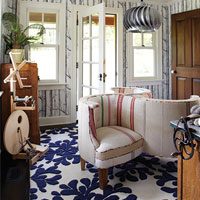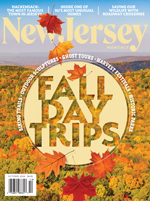

A typical morning at By Pond Farm, the 10-acre Hunterdon County home of interior designer Dan Ruhland and his partner, caterer Larry Craig: rise before 7 am to feed the 90-or-so animals (sheep, llamas, chickens, turkeys, goats, rabbits, dogs and cats); gather a dozen or more eggs from the chickens; and tend to the various herb, vegetable and fruit gardens—all before starting “real” work. Ruhland works mostly from home, while Craig, the proprietor of Laurence Craig Catering, heads to his Maplewood office to plan the menu for a wedding for 200 or an intimate dinner party for 12.
 The farm is their passion, though—a work in progress that has an admittedly steep learning curve. “We’ve had to learn so much about all this just by doing it,” says Ruhland. Although he grew up on a dairy farm in Wisconsin, even he’s out of his element. Craig, on the other hand, grew up in the Middlesex County town of Old Bridge and never envisioned the rural life. The men stumbled on the property while looking for a weekend retreat; weekends eventually turned into full-time, and now the farm life has become their passion.
The farm is their passion, though—a work in progress that has an admittedly steep learning curve. “We’ve had to learn so much about all this just by doing it,” says Ruhland. Although he grew up on a dairy farm in Wisconsin, even he’s out of his element. Craig, on the other hand, grew up in the Middlesex County town of Old Bridge and never envisioned the rural life. The men stumbled on the property while looking for a weekend retreat; weekends eventually turned into full-time, and now the farm life has become their passion.
Starting with a mere six sheep—a sort of lark, the men agree—their brood now resembles an ark, Ruhland jokes, with virtually every farm animal accounted for. While not exactly self-sustained—“We still need the occasional pizza or sushi,” says Craig—the two certainly live and eat well off the farm’s bounty. The chickens produce nearly 150 eggs a week and the gardens yield a harvest of tomatoes, cucumbers, onions, eggplant, blueberries, watermelon—more than 100 fruit and vegetable varieties in all. The pair has even tapped maple trees for syrup and collected fresh honey from their beehives. And, if that weren’t enough, the men discovered yet another hobby: spinning their own yarn from wool sheared from the sheep, llamas and angora rabbits. The time-consuming process starts when the animals are sheared, typically just once every spring (with the exception of the Icelandic sheep, who need it twice a year). Depending on the size of the animal, this generally produces 15 to 20 pounds of raw fleece, which then gets shipped off to be picked clean of debris and washed. The clean fleece comes back closer to 5 to 8 pounds. Craig and Ruhland then spin it—a craft they learned by taking classes—and it becomes yarn. Both men knit, mostly scarves and blankets they give as gifts. “Book a wedding for 200 and you get a free scarf,” jokes Craig.
 While the big red barn is home to an ark-load of farm animals, there’s very little that’s farm-like inside the main house—a 200-year-old center hall Colonial gradually transformed into a chic home. “We wanted to keep the traditional feel but bring in modern conveniences,” says Ruhland.
While the big red barn is home to an ark-load of farm animals, there’s very little that’s farm-like inside the main house—a 200-year-old center hall Colonial gradually transformed into a chic home. “We wanted to keep the traditional feel but bring in modern conveniences,” says Ruhland.
Case in point is the expansive kitchen. Inspired by the beauty and simplicity of the basement kitchens of the Newport Mansions, says Ruhland, the pair gutted three small rooms to make one large space, which also includes a dining area and bar. A hard-working room—Craig is a caterer, after all—the open space is ideal for frequent dinner parties. The floors are made of old bricks from France that add warmth and character, and, best of all, hide spills. The bar counter is patinated bronze, which immediately shows watermarks—but no worries. “We call it a living finish,” says Ruhland. “If you spill something, it’s there forever. That’s part of the charm.”
The living room is thoroughly lived in. With a substantial fireplace on one side, custom-made barn doors conceal the television opposite. The horizontal lines of the wainscot was an experiment that worked, says Ruhland. Craig found Fran, a pig table in a shop in Soho “and just had to have her.”
 In the hobby room‚ where the men do most of their spinning, sits a triple chair, a recent purchase that has become a favorite spot for guests. “They like to sit there and watch Larry put on a spinning show,” says Ruhland.
In the hobby room‚ where the men do most of their spinning, sits a triple chair, a recent purchase that has become a favorite spot for guests. “They like to sit there and watch Larry put on a spinning show,” says Ruhland.
Overall, the look is current and stylish, with a nod to the farm’s traditional past. “Nothing is so precious. It’s all lived in, meant to show its age with pride,” says Ruhland. In fact, it looks assembled over time—just like the many, many animals.




